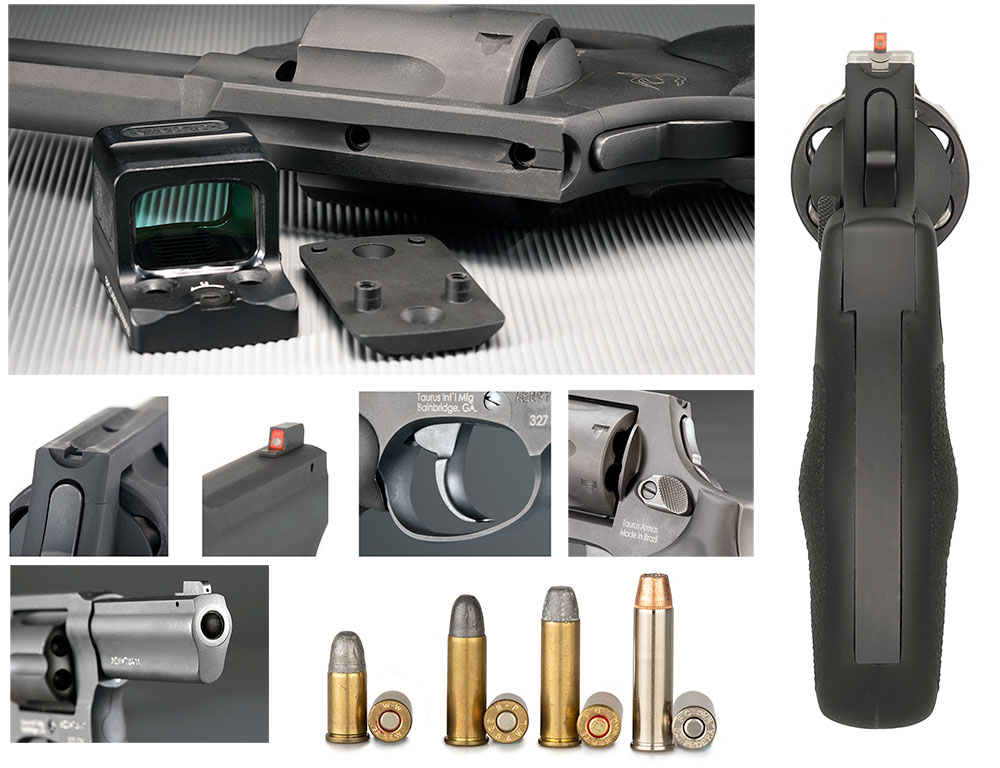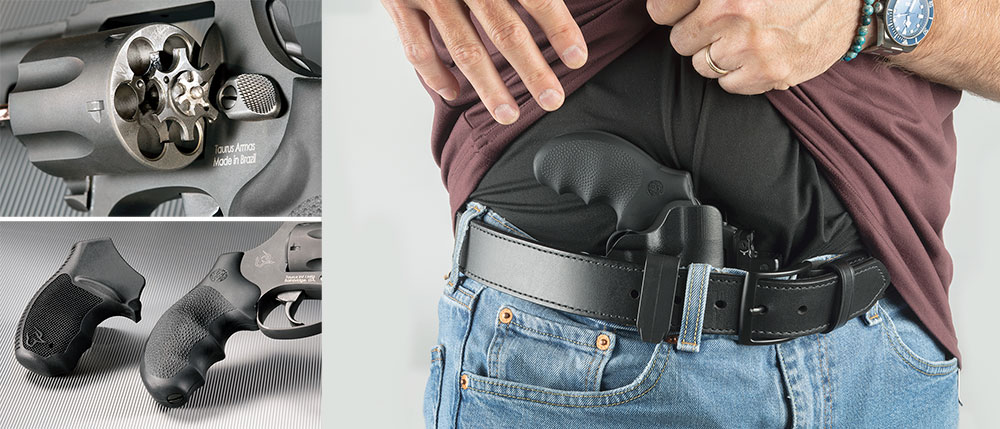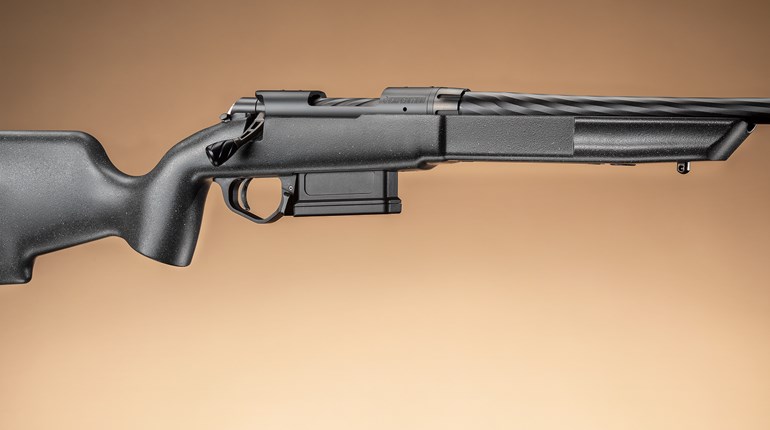
As a long-term fan of the classic wheelgun, I’m delighted to see resurgent interest in revolvers. New models are being offered by both existing handgun manufacturers and some long-gun factories, plus many hopeful CCW applicants are showing up with revolvers at the qualification training classes. After just a couple of short years hosting the annual, two-day Revolver Revolution class at Gunsite Academy, reports are that this year’s attendance has grown from an initial handful of wheelgun diehards to 150 confirmed, paying attendees—and all pre-paid reservations sold out eight months in advance of the scheduled date.
Taurus has been a major supplier of small-frame revolvers to civilians for many years, with a serious focus on the effectiveness of these guns in self-defense applications. The company’s latest offering is the new 327 Defender T.O.R.O. that comfortably handles several generations of .32-caliber ammunition in the same chamber. On the small side, there’s the long-lived .32 Short and .32 S&W Long ammunition that may be hard to find on dealers’ shelves, but does offer new shooters a gentle introduction to the defensive-centerfire-handgun market. The .32 S&W’s peak performance is around 750 fps with an 85-grain jacketed bullet. In the same-length barrel (3 inches) the .32 H&R Mag. adds about 200 fps to the 85-grain bullet, while the mighty .327 Fed. Mag. delivers more than 1,300 fps. For even more power, there’s Speer’s 100-grain GDHP .327 Fed. Mag. load, producing 1,372 fps. We’re talking significant increases in the probability of you surviving a gunfight.

Clint Smith has been credited with saying something about a concealed-carry handgun being comforting rather than comfortable. For those of us who are easily seduced by a mere glance at a pistol (i.e. me), we need be reminded that our first look at a defensive handgun should focus on an evaluation based on “serious” rather than “sexy.” So, I did that, and I was quite impressed by the very serious appearance of the new 327 Defender T.O.R.O. The matte-black finish, combined with a 3-inch barrel rather than the usual 2-incher, immediately announced that this was going to be a “no-nonsense” business relationship. A quick glance at the cylinder showed six chambers rather than five, always an appreciated upgrade in a small-frame revolver, and the Hogue rubber grips with finger groves appeared to be sized right for my hand. A surprise bonus with these Hogue grips is that they position the knuckle of my middle finger slightly under the trigger guard instead of behind it, where the recoil can be a bit painful. Recoil of the .32-caliber family of ammo is a long way from being brutal, but with the heavier .327 Fed. Mag., it will wake you up. The pebbled surface of the Hogue’s made them slip-resistant in the hand, but not aggressive enough to grab any clothing covering the gun during your draw from concealment.
The sighting system appeared to be straightforward, with a fixed, square-shaped groove cut into the rear of the frame and a matching front-sight blade that is replaceable and contains a tritium dot near its base rather low in the orange-colored insert. Usually, a tritium insert is located high in the front sight, but if your 327 Defender is properly zeroed with you focusing on the orange-colored square during daylight hours, you’ll still be making decisive hits when you switch focus to the tritium dot in the failing light. Point-of-impact might be a couple inches higher using the tritium, but that will not be a problem at the close ranges where low-light engagements typically occur. It’s difficult to identify threats in poor light conditions until the bad guys get close. That’s why we carry small flashlights and stay alert.

Fortunately, the biggest advancement on this revolver is its optics mounting system. The setup for adding and removing an optical system on the 327 Defender T.O.R.O. is quite simple and well designed. The compact handgun is shipped with an adaptor mount and two screws. The gun itself has two screw holes in the topstrap/rear sight. Guess what goes where … Once the dot is secured to the mount, you do not have visual access to the rear sight, so there’s no collimated set of optic and iron sight. Should you damage your optic, simply remove the dot and mount and your iron sights are right where you left them and already dialed in. A quick call to Taurus’ PR director and professional shooter Caleb Giddings revealed that the 327 Defender T.O.R.O.’s mounting system would accept both Holosun K-series- and Shield RMSc-footprint optics, and it does so with aplomb.
While the 327 Defender T.O.R.O. does use a hammer-firing system, the hammer is spurless. I’m not thrilled with that simply because it removes some options in deployment of the weapon, particularly if I install a red-dot sight. I’ve been using red dots on some of my hunting handguns for years, and they provide a huge advantage over iron sights in precision placement of shots. That advantage is dramatically reduced if I can’t cock the hammer to take advantage of shooting single action. Yes, most engagements occur at very close distances, but there are exceptions, such as active shooters or a nearby robbery that’s gone bad and spilled into your space. Over the years when Ed Head was at Gunsite, we had many discussions on “when and if” one should consider cocking a revolver. There were several variables discussed, like how good a shot you are or how accurate your carry gun is. But, the final consideration is how much time you have before the perp can reach you, and that is based on how far away the threat is when you become aware of it. The only guaranteed way to win a gunfight is to avoid it, but with an MRDS on my revolver, my life-insurance policy is greatly improved if I’m able shoot it single action.

Having the 3-inch barrel takes the smallframe 327 Defender T.O.R.O. out of the “pocket pistol” category for me. My daily wardrobe is blue jeans, and while the brand I wear nicely conceals a 2-inch small-frame revolver, it won’t completely cover a 3-inch-barreled revolver. And where I live, there’s absolutely no consideration of open carry; showing a handgun can cost you your carry permit. Since my favorite concealed-carry technique is an OWB holster carried strong side and covered by an untucked shirt, there’s no need for me to choose a spurless hammer. Consider the extra weight of the all-steel 327 Defender T.O.R.O., and you’ll quickly give up the idea of pocket carry and start looking for a strong belt and holster combination. Lifestyles, wardrobe and daily circumstances will probably influence your decisions more than personal preferences.
While running the 327 Defender T.O.R.O. on the range at Gunsite, we had three rounds that failed to fire on the first hammer strike. Two of the rounds fired on the second strike; the third never did detonate despite multiple strikes. The failed round was a Federal .327 Fed. Mag. that was left over from a hunting article done a few years back. A heavier hammer, i.e. one with a spur, fired single action, might have avoided those failures.
 The 327 Defender T.O.R.O.’s ejector rod functions smoothly, but the stroke is not long enough for either the .327 Fed. Mag. or .32 H&R Mag. casings to fully clear the cylinder chamber mouths. With the extractor at full extension, case mouths on the shorter H&R cases are still inside the chambers, and it’s even more pronounced with the longer .327 cases. If you don’t interfere with the cases being ejected, pointing the muzzle straight up as you briskly push the ejector downward allows gravity to assist the empty cases in falling clear of the gun. Most successful for me was to hold the gun in my support hand with the cylinder open and use my dominant hand to operate the ejection rod. With my shooting hand above the gun rather than holding the grip, it simply can’t interfere with full ejection. That said, it’s still possible that empty cases in the chambers closest to the frame might not freely fall clear.
The 327 Defender T.O.R.O.’s ejector rod functions smoothly, but the stroke is not long enough for either the .327 Fed. Mag. or .32 H&R Mag. casings to fully clear the cylinder chamber mouths. With the extractor at full extension, case mouths on the shorter H&R cases are still inside the chambers, and it’s even more pronounced with the longer .327 cases. If you don’t interfere with the cases being ejected, pointing the muzzle straight up as you briskly push the ejector downward allows gravity to assist the empty cases in falling clear of the gun. Most successful for me was to hold the gun in my support hand with the cylinder open and use my dominant hand to operate the ejection rod. With my shooting hand above the gun rather than holding the grip, it simply can’t interfere with full ejection. That said, it’s still possible that empty cases in the chambers closest to the frame might not freely fall clear.
Reloading is simple. The fastest technique for me involves the HKS speed loaders I’ve used over the years, but they only work if you’ve run your revolver dry. There’s no partial reloads with these; it’s all or nothing. I like Tuff Products’ Quickstrips that allow you to load as you shoot. For a six-shot revolver, I like an eight-shot strip with an empty space after every two rounds. Those empty slots between rounds allow you slip in a finger and load two chambers at a time with considerably improved dexterity.
On the range, one quickly acquires an appreciation for the extra weight of the all- steel frame/barrel/cylinder 327 Defender T.O.R.O., even if the caliber is just a .32. It’s not like the .32-caliber family produces “crushing” recoil, but the .327 Fed. Mag. does have some noticeable bite (and flash) and could intimidate a new shooter. It’s the enhanced controllability of running the gun through various drills and getting im-proved shot-to-shot recovery times with the heavier loads in the .327 Fed. Mag. that will thrill you. With the .32 H&R Mag. loads, Rangemaster Lew Gosnell and I both took a liking to the Black Hills’ 85-grain JHP and Hornady’s 80-grain FTX for general use. Both loads shoot in the 830-fps range and should be easily controlled/mastered by anyone with a sensitivity to recoil. In a string of semi-rapid fire (making sure hits quickly), with Black Hills’ 85-grain .32 H&R Mag. load, Gosnell put six shots into the Gunsite silhouette target’s “Snot Box” from 7 yards. His trigger finger a little better than mine.
Stepping up to the .327 Fed. Mag. loads, I’ve always heard good things about the Speer family of Gold Dot hollowpoints for defensive use, but I have no field experience with them, which means I haven’t hunted with them. Previously, I’ve taken two animals with .327 Fed. Mag. loads—a wild boar slightly lighter than 100 pounds dropped in his tracks from a DoubleTap 120-grain hardcast that passed through both shoulders and his backbone. A Texas whitetail doe went down immediately when hit just behind the shoulder by an early Federal 85-grain Hydra-Shok. Two shots do not provide a definitive field test, but the indications are that the .327 Fed. Mag. might offer some impressive results in a personal-defense application.
The wheelgun’s trigger pull was smooth when we started on the range at Gunsite and continued to get even smoother. I’ve dry-fired the gun a lot while sitting at my desk writing this article, and it’s quite clear that one or both of us is getting better.
Since the 327 Defender T.O.R.O. is clearly not designed for Bullseye competition, I gave it what I consider a more practical test, given the revolver’s intent as a defensive handgun. It’s an exercise you can try at any indoor range in your urban neighborhood. Standing at the firing line, put a silhouette target at 7 yards (or whatever minimum distance your range allows.) Fire six shots into the chest concentrating on making all good hits. Move your target out to 10 yards and repeat the exercise. Then, move the target to 15 yards and repeat. Keep moving the target and repeating until your target is at the maximum range available. When you are making all good hits and shooting as fast as the range allows, think about adding an MRDS to your 327 Defender T.O.R.O., which, after all, is perhaps the gun’s raison d’être.




































